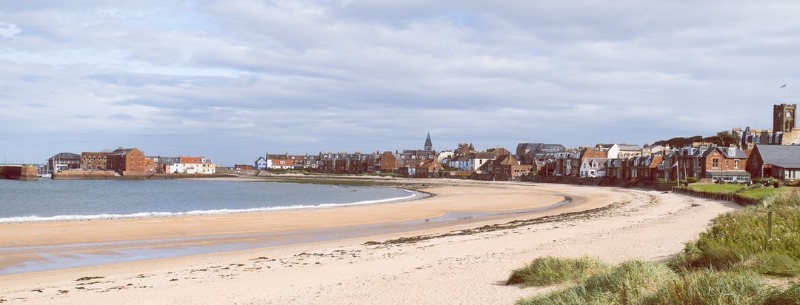Best & Most Beautiful Scotland Beaches
Scotland has some of the most spectacular coastal scenery in the world, from the long sand dunes of the East coast to the rocky shores of Fife with its picturesque fishing villages.
From the cliffs and stacks of Caithness to the West Coast Highlands and Islands, with sea lochs and towering mountains in between, there are hundreds of beaches and tiny sandy bays, mostly remote, deserted and beautiful.
Often, the remoteness of Scottish beaches – particularly those of the northern and western coast – means that they are free from the pollution, which sadly taints many of Britain’s other shores.
Much of this coastline is well worth visiting, but visitors should look carefully and inquire locally about both pollution and hazards before swimming.
Aberdeen
The third-largest city in Scotland, Aberdeen, commonly known as the Granite City, lies 120 miles northeast of Edinburgh, on the banks of the rivers Dee and Don smack in the middle of the northeast coast.
Based around a working harbor, it’s a place that people either love or hate. Certainly, while some extol the many tones and colors of Aberdeen’s granite buildings, others see only uniform grey and find the city grim, cold and unwelcoming. The weather doesn’t help: Aberdeen lies on a latitude north of Moscow and the cutting wind and driving rain (even if it does transform the buildings into sparkling silver) can be tiresome.
Aberdeen can surely claim to have the best beach of all Britain’s large cities. Less than a mile east of Union Street is a great two-mile sweep of clean sand, broken by groynes and lined all along with an esplanade, where most of the city’s population seems to gather on a sunny day.
Towards the southern end of the beach is a burgeoning concrete expanse of cinemas and fast-food outlets, a couple of fairly tatty amusement parks and a vast leisure center.
As you head further north, most of the beach’s hinterland is devoted to successive golf links. Bus #14 goes along the southern esplanade.
Aviemore
The once-sleepy village of Aviemore was first developed as a ski and tourism resort in the mid-1960s and, over the years, it fell victim to profiteering developers with scant regard for the needs of the local community.
Although a large-scale facelift has removed some of the architectural eyesores of that era, the settlement remains dominated by a string of soulless shopping centers and fairly tacky shops surrounding an attractive Victorian railway station.
That said, Aviemore is well equipped with services and facilities for visitors to the area and is the most convenient base for the Cairngorms, benefits which for most folk far outweigh its lack of aesthetic appeal.
North Berwick
North Berwick, twenty miles east of Edinburgh, has a great deal of charm and a somewhat faded, old-fashioned air, its guest houses and hotels extending along the shore in all their Victorian and Edwardian sobriety.
The town’s small harbor is set on a headland which cleaves two crescents of sand, providing the town with an attractive coastal setting. The small museum on School Road (April-Oct daily 11am-5pm; free), housed in the old school house, displays local curios including the old town stocks.
Located in an attractively designed new building by the harbor, the Scottish Seabird Centre (daily: April-Oct 10am-6pm; Nov-March 10am-4pm; Ј4.50) offers an introduction to all types of seabird found around the Scottish coast, particularly the 100,000-plus gannets and puffins which nest on the Bass Rock every summer.
Such is the connection between the rock and its annual visitors that the gannet, once known as the solan goose, takes its Latin name, Morus bassana , from the Bass Rock.
Thanks to a live link from the center to cameras mounted on the volcanic island, you’re able to view close-up pictures of the birds in their nesting grounds. Elsewhere in the center, hands-on games and exhibits explain more about different seabirds, and a mock-up of a cliff face has various stuffed birds nesting on it – all of which, the center insists, were ethically gathered.
Milsey Bay is a sandy bay conveniently situated at the end of a road in North Berwick.
St Andrews – West Sands
Confident, poised and well groomed, if a little snooty, St Andrews, Scotland’s oldest university town and a pilgrimage center for golfers from all over the world, is situated on a wide bay on the northeastern coast of Fife.
Of all Scotland’s universities, St Andrews is most often compared to Oxford or Cambridge both for the dominance of gown over town, and for the intimate, collegiate feel of the place.
Accentuating the comparison is the fact that the student population has a significant proportion of English undergraduates, among them, famously, Prince William, rather to the chagrin of townsfolk who imagine there to be a tabloid photographer lurking round every street corner.
West Sands next to the famous golf course and about 15 minutes walk from the town center. The sandy beach extend for almost 2 miles (3.2km), backed by sand dunes, and with facilities including: cafe; windsurfing; dog restrictions; dog exercise area; pay car park (across road); crazy golf; harbor; campsite.
